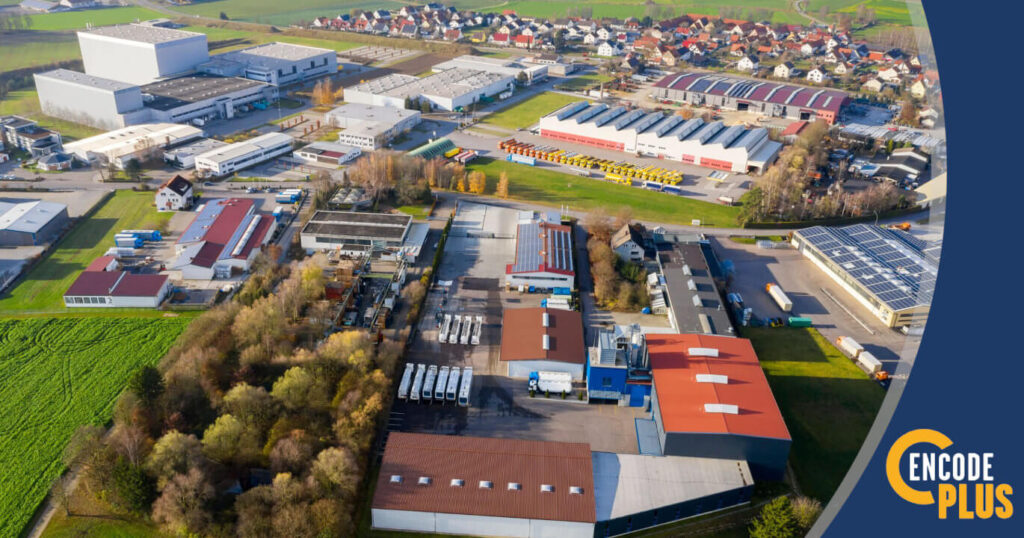
What does a modern, sustainable, green industrial zoning district look like?
Developing industrial districts that tackle climate change while also facilitating investment in 21st century industries requires creative, forward-thinking approaches.
One approach to address greener and more sustainable industrial districts has been the design and development of eco-industrial parks, a collaborative approach of managing environmental and resource issues on one common site. This form of industrial site design requires a high level of coordination and dedication of financial resources to implement. As a result, very few examples exist within the United States. Smaller-scale locations such as the Franklin Eco-Industrial Park in Youngsville, NC, and the Lakes at Green Valley in Griffin, GA, have demonstrated the potential for this model industrial park development.
Industrial zoning district regulations that require a closed-loop, collaborative, eco-industrial park approach may not be a realistic option for many jurisdictions. Instead, by incorporating a variety of environmental and resource-efficient best practices and ecological design techniques into their development codes, communities can lay the foundation for achieving this balance.
What Are Key Elements of a Green Industrial Zoning District?
A conventional approach to zoning for industrial districts tends to focus on elements such as sufficient space to attract industrial uses, provide for vehicle or truck movement and loading needs, and use of performance standards to protect surrounding areas from production spill-overs.
Additionally, designing for open space amenities, landscaped parking and perimeter buffers helps mitigate any external impacts that the industrial site may produce.
All of these factors remain important in developing regulations. But, what if we design those elements to optimize ecological functions and enhance site design with sustainability as the guiding principle?
Many best practices can be applied to facilitate a greener and more resilient form of industrial development. Depending on the location of the district, integrating practices such as land conservation, green stormwater infrastructure, native plantings, passive solar design, and green building design all contribute to ensuring a more sustainable approach to developing industrial districts.
What Does a Modern Green Industrial Zoning District Look Like?
Kendig Keast Collaborative’s recent work with Saint Joseph County, IN, demonstrates this possibility. The county has established an industrial overlay for their Indiana Enterprise Center (IEC), a 2,920-acre industrial district located halfway between the Port of Indiana and the City of South Bend. The purpose for the overlay is to support uses envisioned for the IEC, protect open space through conservation, and establish higher aesthetic and sustainable standards.
The new regulations build in a number of requirements and sustainability goals that all future uses in the IEC must achieve. For example, landscape standards require a minimum of 50 percent of all plantings be native species along with multi-functional design standards integrating practices such as bioretention into the open space as a key site amenity. Planning for energy-efficiency and renewable energy practices also plays a prominent role in the overlay, including the requirement of building-orientation for passive solar performance as well as provisions for incorporating solar panels into parking lot canopies.
Another key feature of the IEC overlay is a sustainability index, providing flexible incentives for incorporating conservation of natural resources, increasing energy efficiency, and using sustainable practices for site development within the overlay. In exchange for designing for sustainability practices, such as achieving LEED certification or generating most energy on site through renewables, an applicant may qualify for additional reductions in parking, signage or landscaping.
Forward-thinking communities such as those highlighted here illustrate that aligning economic development goals with sustainability as a focus demonstrates a model approach. Customizing an approach to urban, suburban, or semi-rural settings requires careful consideration. However, adapting conservation design, green building practices, and ecological performance measures into site-design practices provides the framework and flexibility to support this innovative approach to zoning for industrial districts.
How Can enCodePlus Assist in Developing Green Industrial Districts?
Beyond defining the appropriate uses, design elements, and performance standards, enCodePlus provides many features that can facilitate the design of modern green industrial districts, as well as a user-friendly way to communicate with development applicants. Tools such as development calculatorss for open space, landscaping requirements, or bufferyards can be customized to reflect enhanced conservation and sustainability requirement
About enCodePlus – Intelligent Planning, Zoning and Codification Software
enCodePlus is a unique, web-based technology platform delivering a full suite of planning, zoning and municipal code tools and features, together with full or hybrid code management services. Created by the planning experts at Kendig Keast Collaborative, the platform serves planners and zoning administrators, clerks, attorneys, managers, economic developers, and consultant partners. The cutting-edge software streamlines the rejuvenation of the format and usefulness of plans, studies, codes and ordinances, design guidelines, standards and specifications and the processes to create and publish them.

About the Author of Crafting Development Codes to Solve the Nation’s Housing Crisis
Steve Sizemore, PhD, AICP– Senior Associate, Kendig Keast Collaborative
Before joining KKC, Steve spent many years in the public sector as a professional planner advocating the concept that all plans and regulations should foster desirable community character while also serving to enhance healthy, resilient, and equitable outcomes for all citizens. As a Senior Planner for Louisville (KY) Metro Government, he was a member of the neighborhood planning team, led multi-modal aspects of long-range transportation projects, and co-authored Louisville’s conservation subdivision regulations, Steve has taught in the University of Louisville’s Masters of Urban Planning program, and spoken at national and regional planning conferences on neighborhood planning, active transportation, fair and affordable housing, and conservation subdivisions. He recently achieved his Ph.D. with a dissertation analyzing local government policy in response to a provision of the 1968 Fair Housing Act.